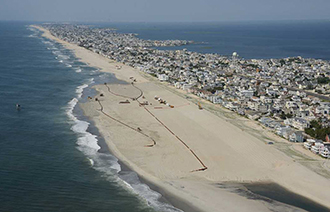Some $186 million in work to raise New Jersey’s beachfront defenses after Hurricane Sandy is starting early this spring, because contractor Great Lakes Dredge & Dock Company has its equipment available four months before the projected start date, the Army Corps of Engineers and state officials said.
In other barrier island towns — where Sandy did even more damage, gouging inlets and washing houses away — the Army corps program was stalled by oceanfront property owners who refuse to grant construction and maintenance easements. That Jersey attitude is being tested as the state takes homeowners to court, arguing the dredge and sand pumping work is a matter of protecting lives and property from storms.
Great Lakes will mobilize in late March, and its dredges Padre Island and Dodge Island will begin pulling sand from seafloor borrow areas three miles offshore for Long Beach Island, just north of Atlantic City, by mid-April, according to the New Jersey Department of Environmental Protection, the Army corps’ partner agency. The dredge Liberty Island will join in August, working off the island’s north end.
In all the project will widen 12.7 miles of beach and build an engineered dune, completing a nearly decade-old effort on the 18-mile strand. Great Lakes also has a $57.6 million contract to replenish an 8-mile section of beach at Ocean City, New Jersey.
Those previously engineered beaches, built in stages over the past decade, got credit for saving towns that were virtually wiped out a half-century before during the great March 1962 northeast gale. That was proof enough for New Jersey Gov. Chris Christie, who promised to build beaches and dunes along the state’s 127-mile coast.
Lawyers for the state and beach towns won some rounds in court against resistant homeowners, who claimed the new dunes cresting 22 feet above sea level block their ocean views and devalue their properties.
Still some of the wealthiest enclaves — like Bay Head, southern terminus of the train line to New York City, and Margate, a longtime resort for Philadelphians — are holding out, arguing their sea walls give them adequate protection. Federal and state officials are pressing on, and say work on those reaches will begin this year even as lawyers argue with holdouts.
The long-term impact of Sandy is making plenty of work for the industry. In 2014 the Army corps spent $345 million in emergency funding to restore 45 miles of previously engineered beaches to their original design state. There’s more than $1 billion of work that was authorized by Congress before the storm, and just two of the smaller projects in Delaware and Raritan bays have been completed so far.




